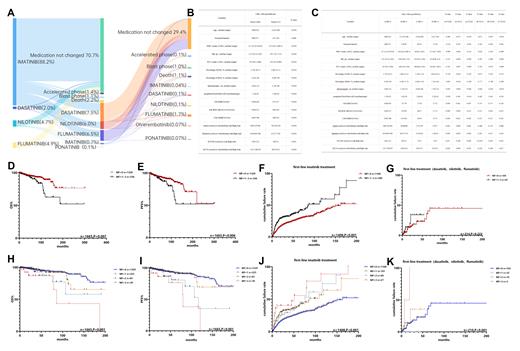Chronic myeloid leukemia (CML) is a hematological malignancy characterized by excessive proliferation of myeloid cells, which belongs to the group of myeloproliferative neoplasms (MPNs). Myelofibrosis (MF) is a significant prognostic indicator of CML, and its discovery at the time of diagnosis aids in decisions regarding the patient's course of treatment, according to a descriptive cross-sectional study. Nevertheless, the influence of MF is not clear. Our study is to investigate clinical characteristics and prognosis of CML pantients with different degrees of myelofibrosis, exploring the influence of MF.
We retrospectively analyzed 1757 CML patients with bone marrow biopsy results and compared the characteristics of CML combined with different degrees of MF in 44 Chinese institutions from January 2010 to October 2022(ChiCTR2200061208). A total of 1757 CML patients with MF, including 1090 males (62.0%) and 667 females (38.0%) with a median age of 49 (6-92) years. 1757 CML patients were treated with TKIs, as shown in the picture ( Figure A).The median WBC count was 119.8×10 9/L (0.1-910.8×10 9/L) in peripheral blood at diagnosis, the median HB level was 111.5 g/L (12.6-181 g/L), the median PLT count was 512.1×10 9/L (5-4384×10 9/L), the median EOS% was 3.3% (0.0-31.1%), the median BAS% was 4.3% (0.0-19.0%), the median spleen size was 4.10 cm (0.0-26.0 cm). Patients with MF were older (p<0.001); had higher leukocyte counts (p<0.001) and platelet counts (p<0.001); were more prone to anemia (p<0.001), acidophilia (p<0.001), alkalophilia (p<0.001), and splenomegaly (p<0.001); and a higher proportion of peripheral blood blast cells (p<0.001). There was no significant difference between the two groups in the male to female ratio. Patients without MF were more likely to reach 3-month EMR (p<0.001), 6-month BCR::ABL IS ≤ 1% (p<0.001), and 12-month MMR (p<0.001). The proportion of medium / high-risk patients with MF according to the Sokal score (p<0.001), Hasford score (p<0.001), ELTS score (p<0.001) and EUTOS score (p=0.002) was significantly increased ( Figure B). CML patients with MF had lower OS and PFS than patients without MF (p=0.007, p=0.006, Figure D, E). CML patients with MF were more prone to treatment failure with imatinib as the first-line treatment (p<0.001, Figure F). There was no statistically significant difference in treatment failure between first-generation TKI (1G-TKI) and second-generation TKI (2G-TKI) (p=0.222, Figure G).With increasing degree of MF, CML patients had higher leukocyte counts were more susceptible to anemia and splenomegaly, and had more peripheral blood blast cells. However, there was no significant difference in sex ratio, age, platelets, eosinophils, and basophils. CML patients without MF were more likely to achieve 3-month EMR, 6-month BCR::ABL IS ≤ 1%, and 12-month MMR. As the degree of MF increased, the proportion of intermediate / high risk patients according to Sokal score, Hasford score, and ELTS score increased significantly ( Figure C), OS and PFS of CML patients decreased (p<0.001, p<0.001, Figure H, I) and the failure rate of first-line treatment increased (p<0.001, p<0.001, Figure J, K).
In conclusion, we performed 1757 CML patients with MF and compared the characteristics of CML combined with different degrees of MF. As the degree of MF increased, the proportion of intermediate / high risk patients according to Sokal score, Hasford score, and ELTS score increased, the efficacy of TKIs was lower, the prognosis of patients was worse. So MF is an independent risk factor affecting the prognosis of patients with CML.
Acknowledgement: This research was funded by the Key R&D Program of Zhejiang, No. 2022C03137; Public Technology Application Research Program of Zhejiang, China, No. LGF21H080003; Zhejiang Medical Association Clinical Medical Research special fund project, No. 2022ZYC-D09.
*Correspondence to:
Dr Jian Huang, Department of Hematology, The First Affiliated Hospital of Zhejiang University School of Medicine, Hangzhou 310003,Zhejiang, Peoples R China.E-mail: househuang@zju.edu.cn
Disclosures
No relevant conflicts of interest to declare.


This feature is available to Subscribers Only
Sign In or Create an Account Close Modal